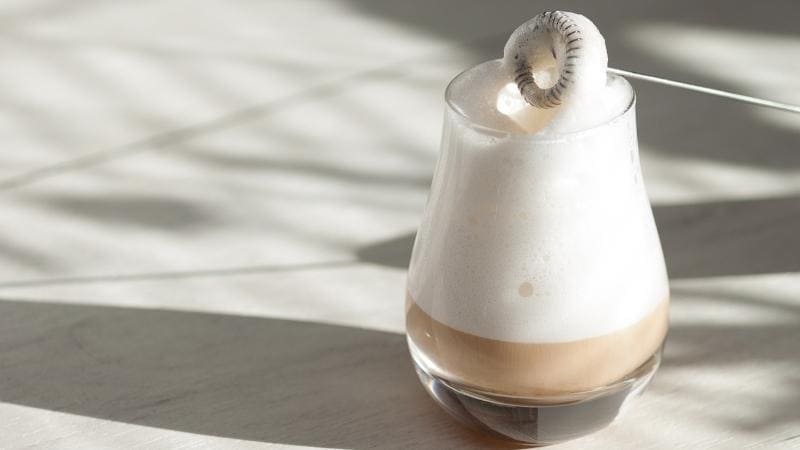
Have you ever tried Galao coffee? I must confess, I just recently found this amazing Portuguese beverage, so if you also like trying new things, you’re in the right place! Let’s get to know the Galao coffee and how it differs from a latte.
Galao vs Latte coffee:
A Galao contains more milk, combining three-quarters of frothed milk with an espresso base. As for a latte, the milk is typically steamed rather than frothed, with one espresso, two parts milk, and a very thin layer of foam on top.
Since Galao is a close match to a latte, both the consistency of the milk and the milk-to-coffee ratio are critical differentiating factors when compared to a Latte.
| Difference | Galao | Latte |
|---|---|---|
| Taste | Sweet and milky | Creamy and sweet |
| Variations | Meia de Leite (Half of Milk), Um Pingo (Spanish cortado) | Iced Latte, Latte macchiato, Vanilla Latte, Chai Latte |
| Milk content | 3/4 or approximately 75% of frothed milk | 2/3 or approximately 67% of steamed milk |
| How to serve | Hot | Hot |
| Prep Time | 5 mins | 5 mins |
| Caffeine level | Standard is 1 shot of espresso which is about 90-100 milligrams. (Source: USDA) | Also made with 1 shot of espresso as a standard, which is about 90-100 milligrams. (Source: USDA) |
| Origin | Portuguese | Italian |
Galao Coffee Explained
Galao is a signature coffee made in Portugal and is most comparable to a latte or cappuccino. Galeo coffee is rich, milky, and sugary. Presented to the customer in a tall glass, the Galao is one of the most popular drinks found in coffee shops or pastries around Portugal, and for good reason.
The beverage is excellent for breakfasts or brunches, and it can be served in the traditional manner of Portugal, along with a savory-sweet pastry on the side, Simple and uncomplicated to prepare.
Galao’s texture, taste & flavor
While the foam guarantees that the milk is not overheated, the velvety smoothness of the foam is what it’s all about, Galaos are thicker and less potent than espressos.
With three essential ingredients: water, coffee, and milk foam, there are various taste profiles to be obtained from the espresso used depending on the type of roast and coffee beans variety, from chocolaty to spicy to flowery…
The barista’s brewing ratio and temperature also affect the taste and uniformity of the beverage. Like Italian coffee beverages, Galao coffee’s milk is textured like most Italian coffees.
The drink is the right combination of three-quarter hot foamed milk and a quarter coffee that tastes radically different in Portugal than when it’s duplicated anywhere else in the globe.
Simple in composition, yet it’s difficult to express how excellent and unusual the taste of this refreshing beverage is. It’s the sort of drink that catches you by surprise and makes you lose your breath for a second.
Galao coffee Caffeine content
Using an estimated caffeine content of 64 mg per fluid ounce, a Galao is traditionally made using one shot of espresso. That said, many other factors may affect the caffeine content in your final cup (Coffee beans used, the Brewing method, equipment, …)
In terms of flavor and consistency, a Galao is a latte or cappuccino-style coffee that’s uniquely Portuguese.
Origin of the Galao Coffee
Portugal imports green beans from South America and Africa, which are subsequently roasted by local coffee companies. As a matter of fact, the only coffee plantation in Europe is in a tiny village on S. Jorge Island (Azores) where a local has a small farm.
Roasting processes have been refined since the 18th century, thanks to a long history of experience. In most nations, espresso is made with 100 percent Arabica coffee beans, which results in a more aromatic beverage.
The coffee used in Portugal, on the other hand, is a slow-roasted blend of Arabica and Robusta beans. Full-bodied, less acidic, and “thicker” are characteristics of an excellent Portuguese espresso.
Now let’s talk about the latte; I know you’ve heard so much already, but there’s more:
What’s a latte?
Espresso and steamed milk are combined to make a latté, with a tiny coating of foam on the surface, and a mellower, creamier variation of the espresso taste is created.
What does latte taste like?
As explained in our Latte guide here, A latte has a smooth and mildly sweet flavor that balances out excellently with the pleasant taste of caffeine.
Generally, a latte is not a strong-tasting drink, mainly because the milk offsets the bold taste of coffee with a creamy, frothy texture.
You can also enhance the flavor by topping the drink with vanilla, hazelnut, etc. If you don’t like your coffee too strong, a latte is a great choice.
When ordering lattes, you can get them with either a single or a double dose of espresso.
Café Latte Variations
Café lattes come in several variations as coffee shops tweak their recipes to stand out from the rest. Some lattes don’t even include espresso, instead, they substitute it with tea leaves such as mate, matcha, or chai.
How to prepare Galao Vs latte?
How to prepare Galao:
Equipment:
- An Espresso Machine
- Heat Source
- Coffee Jug
- A Milk Frother
INGREDIENTS
- ¼ Coffee, 1 espresso shot is a standard
- Cup of Water
- ¾ Milk
- 1 sugar
INSTRUCTIONS
- Pull an espresso shot, or a double ristretto.
- Froth the milk to the desired texture, not too creamy, just the right amount of silky and creamy textured milk.
- Pour the frothed milk on top of your espresso, the espresso and milk will mix at the bottom of the large glass, and a giant froth will crown the surface.
How to make a latte:
I’ll show you how to make it without the Espresso Machine, which is the traditional way.
EQUIPMENT
- Heat Source
INGREDIENTS
- Freshly ground coffee beans
- One cup of cold milk
- ½ Sugar
- 1 Cup of Water
INSTRUCTIONS
- In a coffee cup, combine espresso powder, water, and sugar (if desired). Then, set aside for now.
- In the meantime, heat milk in a microwave-safe cup for 30 seconds (for milk at room temperature) or 50 seconds (for milk that has been chilled, for refrigerated milk). Put the lid on the heated milk and aggressively shake it for 60-80 seconds. Foam is made using this method.
- Remove the lid and have a look inside. Return the milk to the microwave and heat it for a few more seconds. For the next 30 seconds, continue to boil till the foam reaches your desired form.
- Pour the warm milk into the espresso mixture using a spoon to slide the froth backwards. Top with the white foam and gently press down. If desired, dust with chocolate powder before serving.
A Galao Pros & Cons!
Below I’ll list some pros and cons of taking a Galao:
Advantages
- Drinking Galao coffee may help you fight oxidative stress.
- May aid in weight loss.
- Drinking Galao may help you stay awake and focused.
- Niacin and riboflavin are only two of the many nutrients found in espresso.
- Comparatively milder in flavor than a regular shot of espresso
Disadvantages
- Sleep problems may be worsened or caused by it.
- Restlessness and overstimulation of the nervous system.
- Equipment for making espresso is rather costly.
- It might cause stomach problems if consumed in significant numbers.
The best milk to use for cafe latte?
Whole milk is the most excellent option for a cafe latte. Whole milk contains the most lactose. Although 2 percent milk still works OK, you will lose some of the richness in flavor. The most critical consideration is how fresh it is. When milk nears its expiration date, its foaming ability decreases significantly.
How is the Galao served?
If you wish to order Galao at a coffee shop or pastry store when visiting Portugal, mention The galo (Pronounced: Gah-lo), and they will bring your requested coffee.
Finally, A traveler posting on Traveldudes had some beautiful words to say:
Then, sip or gulp, and enjoy the galão, the views on the street, and everything else that goes along with this charming city, and stay as long as you want as most café waiters in Portugal will never bother you to move even if you decide to spend hours on just one drink
Wrap up
I think it’s remarkable how similar the Galao and latte are yet they taste so different. Every day, the world of coffee amazes me in new ways.
To return to the question of Galao Vs. Latte, I would say your personal preference will play a significant role.
Both coffees have a sweet and creamy taste, while the Galao tends to lean more towards a milky taste due to its higher milk proportion. For me, I find both beverages to be excellent in their own way.
